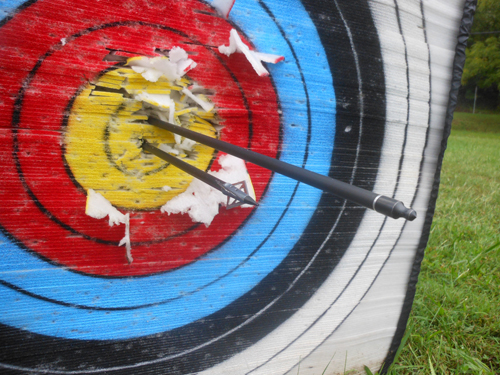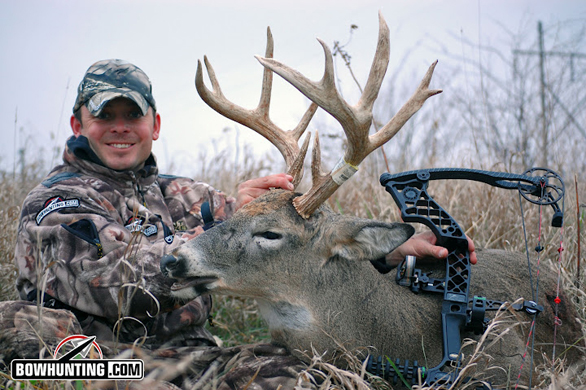LAST UPDATED: May 1st, 2015
What the FOC? Before you come unhinged at the thought of your favorite bowhunting site delving into the blatant use of profanity, it is merely a catchy way to get your attention regarding the latest tool to help you be the best bowhunter you can be. In addition to bringing you valuable content, tips and tactics, Bowhunting.com is happy to offer a “hands-on” tool that can help you make the best decisions when it comes to one of the most important pieces of equipment you will take into the timber this fall….your arrow. After all, along with the broadhead, it is the only thing that touches your trophy standing down range.
When your arrow’s Front Of Center is optimal, fieldpoints and broadheads are capable of identical performance.
When it comes to poor arrow flight, unfortunately most of the blame gets placed on the broadhead resting at the business end of the arrow in question. Of course, the problem couldn’t possibly be the result of something we have control of. No, it must be another badly designed broadhead that just doesn’t fly right…right? Well, not entirely.
When it comes to arrow flight and broadhead performance most of the blame should land squarely on our shoulders. After all, we are the ones piecing together the bow rig; more specifically, matching broadheads with arrows, and arrows to bow. And there my friend is where the problems begin. Unless the matchup is ideal, top performance will never be reached and “poor design” will likely become our scapegoat. However, the truth is one of the most important factors affecting arrow flight (especially with broadheads) is the amount of FOC your current arrow is carrying.
Accuracy is everything. If your current setup isn’t performing how you wish, the problem may not be the broadhead, but instead the result of poor FOC.
If all of this sounds familiar, you’re not alone. For many bowhunters, trying to find the perfect broadhead/arrow relationship is akin to finding a 200 inch whitetail. However, Bowhunting.com wants to make it easier for you. We want you to get started in the right direction when it comes to arrow flight and performance. But let’s face it, if you don’t know what you are working with, how can you possibly know how to fix the problem.
Equipment that does what it is supposed to do builds confidence. Confidence in your equipment will definately lead to shorter bloodtrails and bigger smiles.
FOC is an acronym for the phrase “Front Of Center” and it refers to a process that bowhunters use to determine whether or not the relationship between their broadhead and their arrow even stands a chance. Essentially, it is the percentage difference between the “physical” midpoint of the arrow and the center of gravity (balance point) of the arrow—-as compared to the overall length. An arrow’s Front Of Center weight is critical in attaining optimal flight because if the center of gravity and center of pressure on the arrow are too close to one another the arrow will become unstable in flight.
So what does this mean to those of that aren’t sceintists? This means that if more of your total arrow weight is in the front half of your arrow, you will get better arrow flight. Before discussing how to get more weight up front, let us figure out how to get the proper measurements.
Overall arrow length is measured from the front of the shaft to the throat of the nock. The throat of the nock is the portion that sits directly against the string. Make sure this measurement does not include the tip or broadhead length.
To measure for the balance point, insert the tip or broadhead into the insert and balance the arrow on a single point. A block of wood (as shown in the photo) works very well, you can also use the rounded (tube)portion of a ball-point pen as your balance point. When the arrow is balanced, mark the balance point with a pencil and measure from the pencil mark to the throat of the nock.
Now that you have these measurements, you are ready to utilize Bowhunting.com’s new FOC Calculator. It can be found under our Resources drop-down list at the top of the page. Find it, use it, and get the facts about your current setup. Keep in mind that proper arrow spine, arrow rest tuning and proper shooting form are also key elements when trying to achieve the best arrow flight.
Why is the FOC percentage important? When a bow string is released an incredible amount for force is placed into the back of the arrow, essentially trying to push the nock end of the arrow past the tip. Fortunately the stiffness and length of the arrow won’t allow this happen, but it does cause the arrow to porpoise or form a very wide “u” shape, springing from one side to the other. The longer the arrow “porpoises” towards the target the poorer the flight of the arrow will be. The more weight there is at the front of the arrow, the quicker the arrow recovers to being a straight piece of material, thus allowing for better arrow flight.
The final step, how do archers increase their FOC percentage? There are only two ways to increase the FOC percentage; add weight at the front or decrease weight at the rear of the arrow. Decrease weight at the rear isn’t as easy as adding weight up front. You still need a nock and fletchings but eliminating wraps or shooting smaller fletchings are options. To add weight up front you can increase your broadhead weight, add weighted inserts inside the arrow shaft or buy heavier threaded inserts where the arrow tips screw into.
Add a little weight up front and get your arrows back on target.

 By
By 





